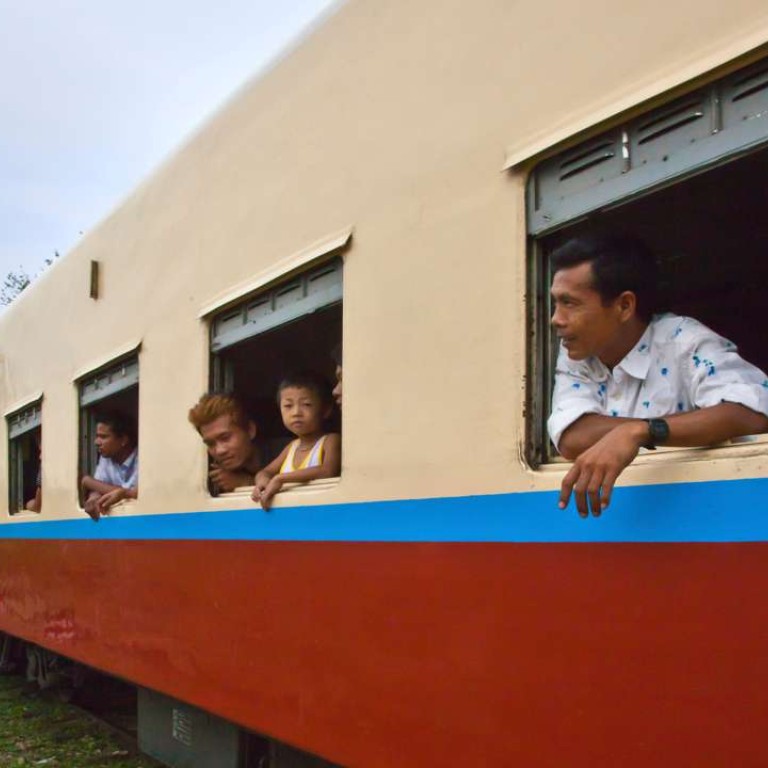
Why Myanmar by train is a bumpy bargain ride
Slow, grubby and unreliable, the Southeast Asian country’s trains offer just enough discomfort to make them perfect
The Yangon Circle Train, which winds its way round the suburbs of Myanmar’s former capital, is surely one of the world’s great railway bargains. A ticket for a three-hour journey costs 200 kyat (HK$1.20). The pace is so leisurely, the clackety wheels so hypnotic, the air pouring through the glassless windows (there are shutters for when it rains) so sultry that the carriages have a sign – a boy and a girl mid-clinch with a red line sternly dividing them – that indicates no canoodling is allowed.

Faster, however, is not a hallmark of Myanmar trains, though this, like everything else, is changing. Now that the country’s eagerly arrived – face scrubbed clean(ish) – on the world stage, it’s trying to improve transport infrastructure, both domestic and international.
It’s only ever had one cross-border rail link, the Death Railway to Thailand, built by Japan during the second world war using forced labour and later destroyed. History can run circular, too: in July, Japan donated US$200 million to upgrade the Yangon Circle Train. But, for the moment, train speeds tend more towards the bullock than the bullet.
The Circle Train meanders into Yangon Central Railway Station, which, with its glittering roofs, looks like a vast, municipal version of the city’s pagodas. (Myanmar Railways is hoping to develop it into a high-rise shopping mall.) The actual ticket office, inexplicably hidden on the far side of the tracks, looks like a deserted Irish mart, complete with roosters pecking in the dust.

There, I book a single to Bagan in a four-berth sleeper. It costs 16,500 kyat for a trip lasting 19 hours, two more than promised on the timetable. (So wondrous was the original Yangon station, built by the ruling British in 1877, it was nicknamed Fairy Station, and elements of the mythical still linger.) There is a single grubby sheet on my bunk bed, several billion insects surge through the windows and into my mouth on the stroke of dusk, the February night is chilly and the constant night-time jolting – Myanmar trains have a reputation for unconscious uncouplings – mean it is like sleeping, or trying to, on a trampoline.
In other words – just enough discomfort to make it perfect.
In what might loosely be called the dining car (an actual fire roaring away in a corner), the cook sings while I lean out to wave to children, their cheeks pale with thanaka paste, Myanmar’s universal sunscreen; at twilight and dawn, it is as if tiny ghosts are flitting near the track. Village women sit smoking in doorways that feel so close this non-smoker is tempted to pinch the cheroot from between someone’s lips, take a quick puff and return it, all in a heartbeat. Sometimes, when we pass village carts, I think that if I stretched far enough and rub an ox’s ashy nose, it would leave a smudge on my hand.

Most of all, there are the magnificent trees, rearing over the train at halts – so huge and shapely and rooted, they seem the quintessence of treeness. I keep on writing “Trees!” in my notebook, as if I’ve never encountered one before; later, in the National Kandawgyi Gardens, in Pyin Oo Lwin, it is the 589 tree species I want to inspect. (And when I came back to Hong Kong, people who’d travelled around Myanmar by plane, not hanging out of train windows, said blankly, “Trees?”)
Pyin Oo Lwin – formerly called Maymyo and, at 1,066 metres, British Burma’s summer capital – is about 70km from Mandalay, and an ideal base from which to make a Gokteik viaduct day trip. On my first morning, however, a train has jumped the tracks at Mandalay and the Lashio Mail is running many hours late. The Pyin Oo Lwin station master chalks up an approximate time of arrival: 12.30pm, then carefully adds the word “guess”. I visit the Botanic Gardens.

On the second morning, there is another delay, but a man in the station office, busily ruling lines into an exercise book, says the Up train might arrive by 11am. I buy a single to Nawngpeng, the first stop beyond the viaduct. This trip of a lifetime, crossing what was once the world’s largest railway trestle and is still Myanmar’s highest bridge, costs 700 kyat (HK$4.50; including 0.50 kyat for life insurance).
“The British only built the railways,” an elderly local man on the platform informs me. “They cannot build the bridge.” This is true. The Gokteik viaduct was built by the Pennsylvania Steel Company, which, in 1902, produced a little booklet about its achievement called From Steelton to Mandalay, now available on the internet and worth looking at just for the construction photos, which resemble a parade of gigantic steel insects devouring a tropical gorge. But at least Burma’s British lieutenant-governor managed to insert the last of a million rivets – which was silver - at the opening ceremony.

Eventually, the Lashio Mail appears. I watch a man crawl underneath, conduct some vigorous hammering and re-emerge. Then we leave – many locals in hats, carrying baskets and mysterious lumpy packages, plus some tourists heading for Hsipaw, further up the line, all of us jammed companionably into the bouncing carriages. The seats are, usefully, wooden; when the baby next to me pees everywhere, it is but a moment’s work to mop it up.
It takes almost three hours of lovely, tangled, verdant landscape to reach the viaduct; you glimpse its stern lines with initial disbelief, then it disappears as the train switchbacks, it re-emerges, it grows, is upon you. The train (further) slows, the gorge yawns 250 metres below, you carefully bridge a piece of railway history with a full heart.
I look at the date of my ticket: it’s Valentine’s Day.
